The Catahoula Leopard Dog is a unique American breed known for its eye-catching coat and versatility in the field. From its roots in Louisiana, this breed has been a reliable partner for hunters and livestock herders. The Catahoula’s coat is remarkable, displaying a variety of patterns, including spots similar to a leopard, and it has a sturdy build ideal for its historical work.
These dogs have a hunting instinct but are also intelligent and responsive to training when given clear and steady instructions.
Catahoulas flourish with human interaction, requiring regular activity and challenges to stay well-behaved. Their devotion and protective instincts make them an excellent addition to any household. Engaging them with physical exercise and intellectual tasks keeps them content and prevents negative behavior.
Known for their unwavering loyalty, Catahoulas become cherished members of the family.
Key Takeaways
- Catahoula Leopard Dogs boast striking spotted coats.
- They excel in hunting and respond well to consistent training.
- Catahoulas need engagement through exercise and mental stimulation.
Originating from Louisiana, the Catahoula Leopard Dog is prized for its distinct coat and multipurpose abilities in work environments. These intelligent canines show a keen aptitude for hunting and thrive under consistent guidance. Providing ample well-being and mental activities is essential to foster their well-being. Their protective, solid nature and loyalty make them valued family members, thriving on close human bonds.
Quick Facts
The Catahoula Leopard Dog may not be as famous as other breeds, but its distinctive coat pattern catches the eye. Often adorned with a merle pattern, their fur displays a beautiful mix of colors that extends to their skin and eyes, adding to their striking look.
These dogs carry the title of the official Louisiana State Dog, a nod to their roots that trace back to the mid-1700s when French settlers in Louisiana mixed their dogs with native breeds.
Ranked in the top 200 by the American Kennel Club for breed popularity, Catahoula Leopard Dogs have a muscular build, standing 22 to 24 inches tall and weighing 50 to 95 pounds. They typically enjoy a lifespan of 10 to 14 years, making them enduring companions for those who appreciate their heritage and versatile abilities.
Catahoula Leopard Dog Pictures

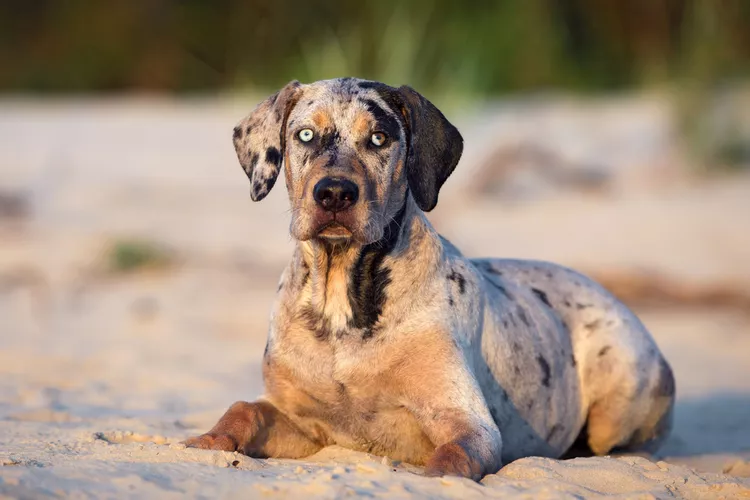
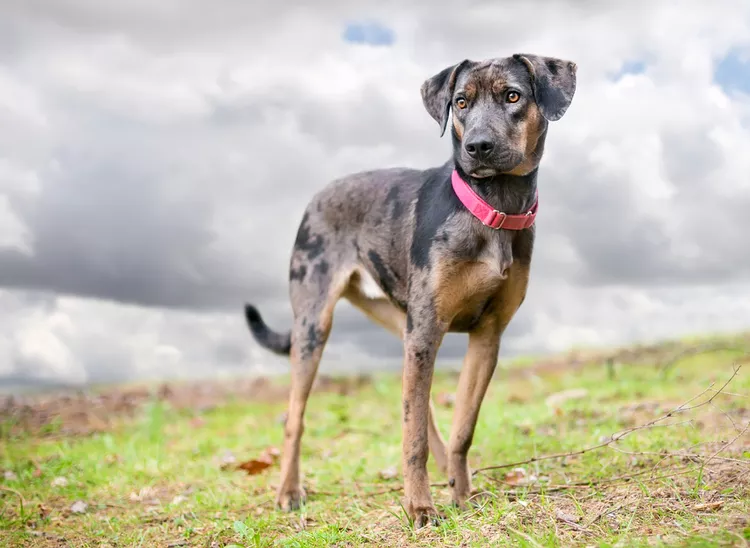
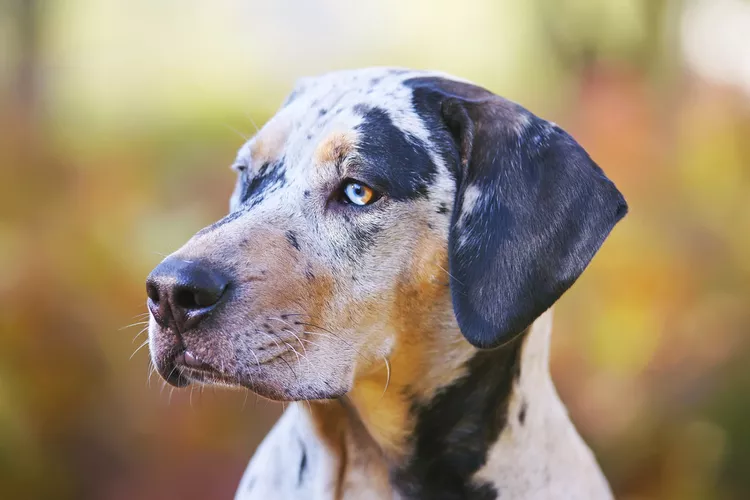
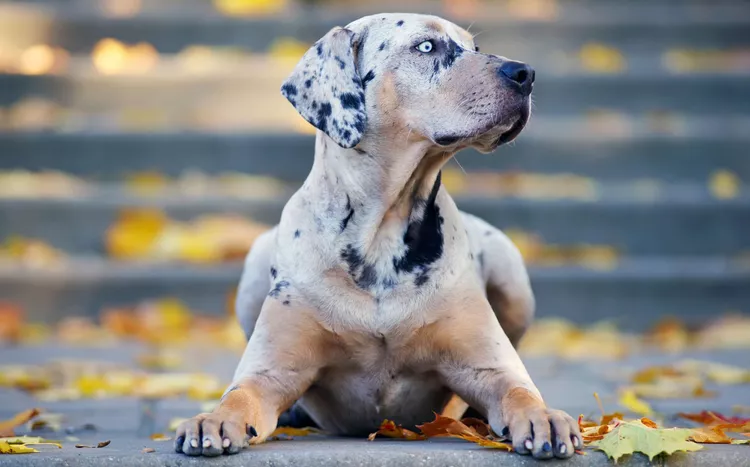
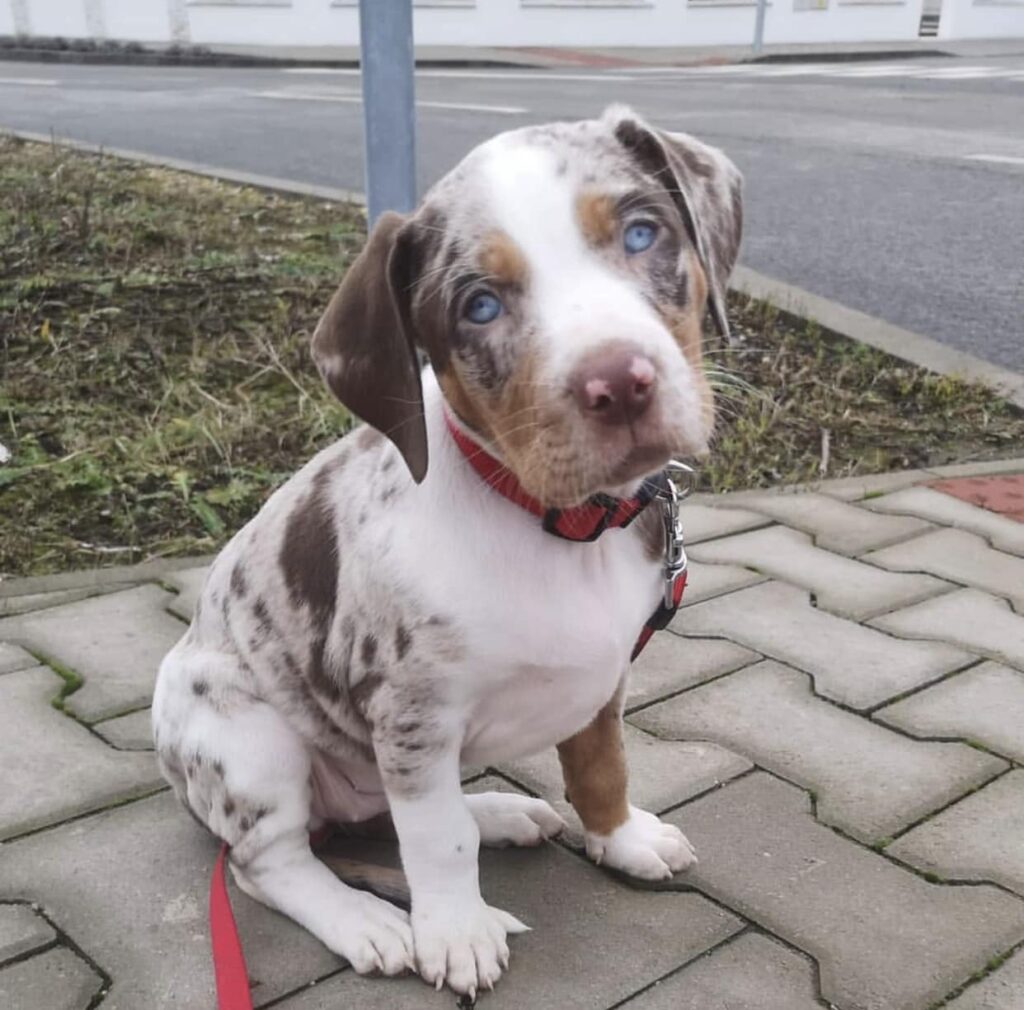
Overview
The Catahoula Leopard Dog has evolved from its original hunting and herding duties in Louisiana to become a versatile companion. They are visually impressive and skilled workers with muscular physiques and striking coats that vary from merle patterns to single colors.
Their webbed feet are a distinct feature that suits the challenging landscapes of their home state. Regular exercise and early training ensure these high-energy dogs stay healthy and well-behaved.
Key Traits
The Catahoula Leopard Dog is a remarkable combination of Spanish Mastiff, Bloodhound, and American Dingo heritage. Known for their sharp intelligence, boundless energy, and strong sense of independence, these dogs excel in various work settings. Their coat, which can show a beautiful array of colors, often features eye-catching merle patterns and is medium length.
Owners should provide these dogs with consistent exercise to keep them healthy in body and mind. The table below summarizes their main characteristics:
| Trait | Description |
|---|---|
| Intelligence | Quick to learn with a natural ability to solve problems. |
| Energy | Needs plenty of daily activity due to their vigor. |
| Coat | Sports a medium-length single coat with diverse colors. |
Proper socialization and training from an early age are essential for these independent and protective canines. They do best with plenty of room to roam and activities to engage their active minds and bodies.
Breed Origins
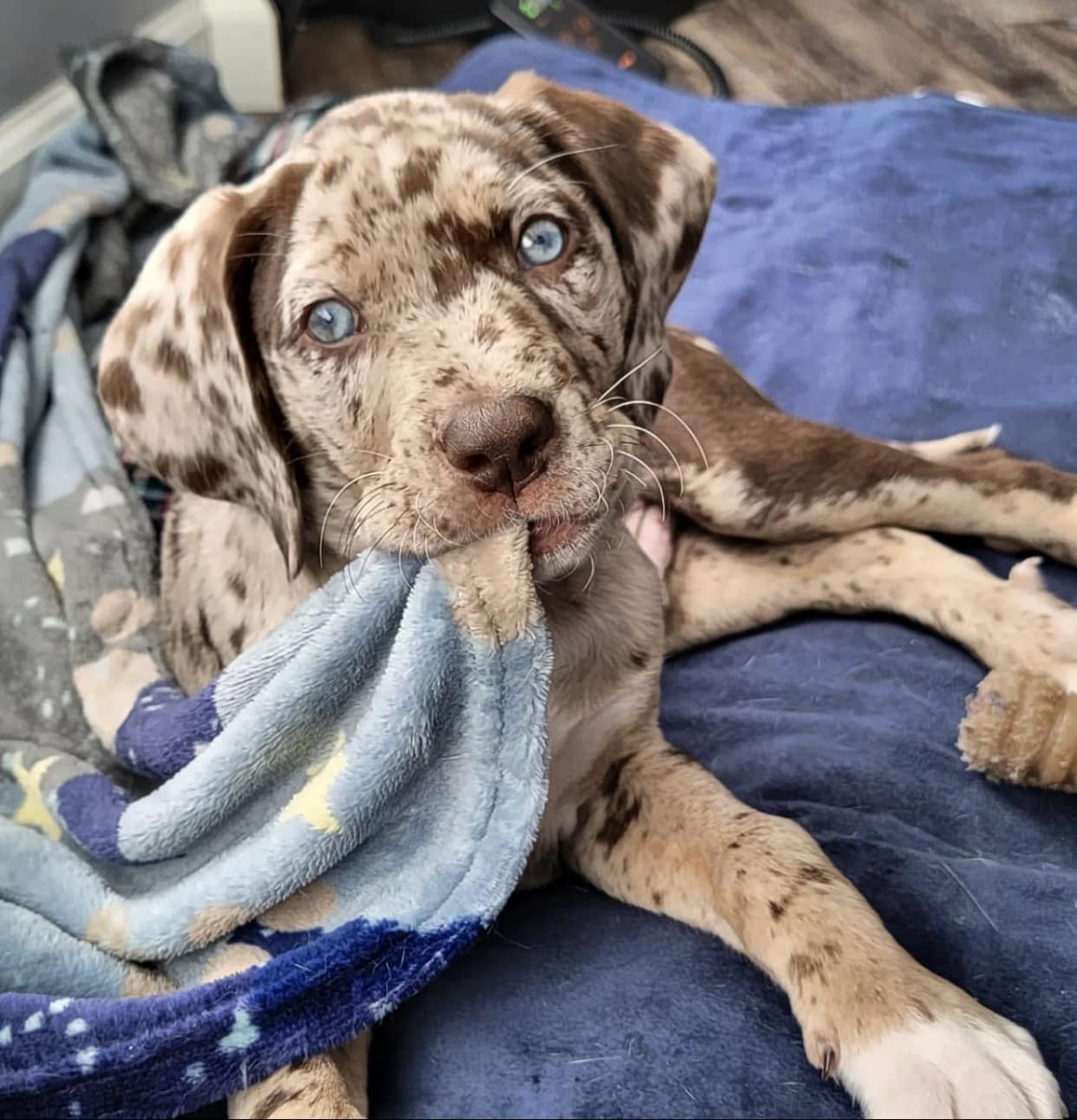
The Catahoula Leopard Dog has a rich history that intertwines the heritage of Native American dogs with European breeds. This mix has created a unique and versatile breed.
Louisiana has officially recognized the Catahoula Leopard Dog, highlighting its significance in the region’s culture and history.
This breed has adapted to various jobs throughout history, showing an impressive ability to switch from hunting to herding.
These aspects of the Catahoula Leopard Dog’s background shed light on its evolution and strong impact over time.
Native American Roots
The Catahoula Leopard Dog is a distinct breed that emerged from the crossbreeding of Native American wolfdogs with dogs brought over by French settlers. This mix was intentional, focusing on creating a dog that could easily handle Louisiana’s swamps while being skilled in herding and hunting.
The breed gets its name from the Choctaw language, which translates to ‘sacred lake,’ which ties it closely to its origins near Louisiana’s Catahoula Lake. The successful blend of these dogs in the 1700s resulted in a breed integral to Louisiana’s cultural heritage.
Louisiana State Dog
The Catahoula Leopard Dog held a special place in Louisiana’s heritage and was recognized as the official state dog in 1979. This breed’s journey began in the 1700s through careful breeding by early French settlers and Native Americans, who aimed to create a dog that could adeptly manage the local landscape and wildlife, especially for hunting and herding.
The Catahoula’s lineage includes a mix of Spanish Mastiff, Bloodhound, and the native American Dingo, giving it a fine-tuned ability for tracking large game and overseeing livestock. These skills played a significant role in the Catahoula Leopard Dog becoming a symbol of Louisiana.
Historical Working Roles
The Catahoula Leopard Dog is a versatile breed that excels in various roles, from herding animals to big game hunting.
Originating in the mid-1700s, French settlers in Louisiana mixed their dogs with the local Native American dogs adept at swamp hunting. This combination resulted in a breed with solid herding skills, particularly with cattle and pigs.
These dogs gained a reputation for their ability to manage wild hogs, which was an essential job in the region. As the 1800s progressed, breeders refined the Catahoula’s instincts, further enhancing its abilities.
Their distinction in herding and hunting led to the Catahoula Leopard Dog being honored as the official state dog of Louisiana.
Physical Dimensions
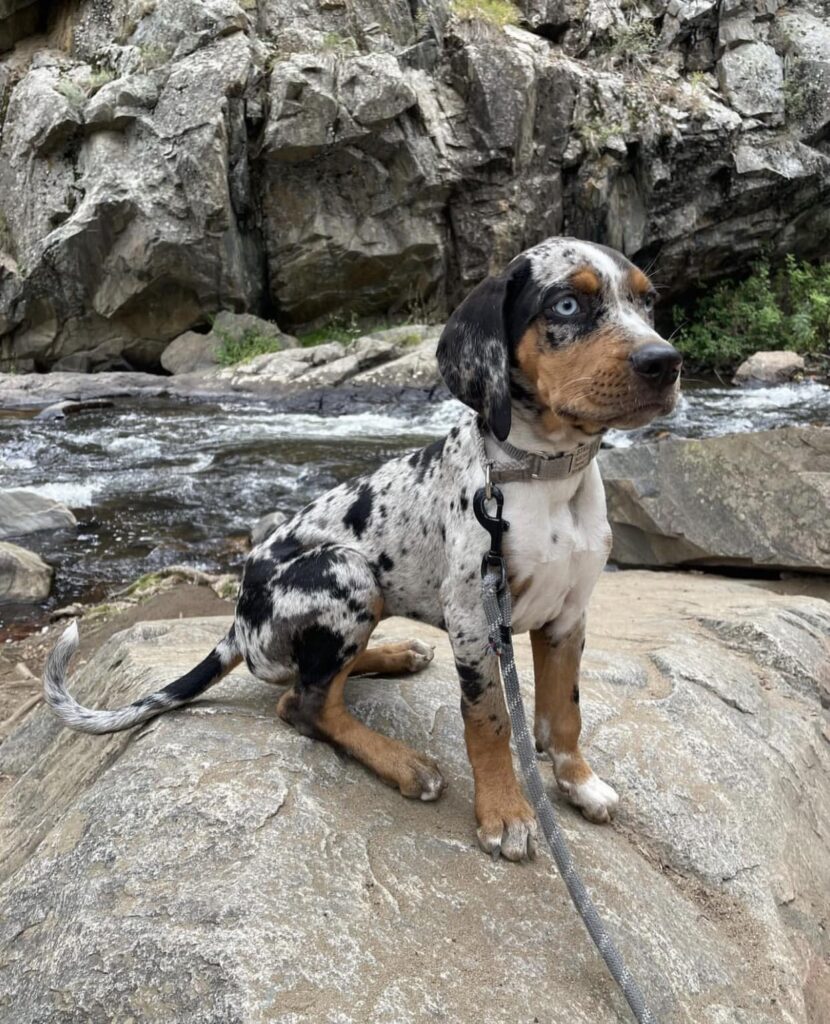
The Catahoula Leopard Dog is known for its muscular build and active lifestyle. There are specific measurements to keep in mind to ensure they’re healthy and developing correctly.
Adult dogs of this breed typically weigh between 50 and 95 pounds. Their height, measured at the shoulder, usually falls between 22 and 24 inches. The breed’s muscular body is somewhat rectangular, a nod to its history as a hardworking dog.
Monitoring these sizes helps confirm that a dog matches the breed standards and gives clues about their individual growth.
Average Weight Range
Adult Catahoula Leopard Dogs usually weigh between 50 and 95 pounds, with males often being heavier than females. However, genetics and overall health play a significant role in determining their weight.
Keeping a Catahoula Leopard Dog within this weight range is vital for preventing health problems, especially joint issues like hip dysplasia.
Regular vet check-ups can help monitor your dog’s weight, ensuring they stay healthy and fit for their unique needs.
Height Measurement Variability
Catahoula Leopard Dogs show a wide range of heights, typically standing between 20 and 26 inches at the shoulder. This variation reflects the breed’s rich genetic makeup and the effects of selective breeding for different jobs and environments.
Maintaining the breed’s unique physical traits is a top priority for breeders and enthusiasts. That’s why height is measured using precise equipment, ensuring that each dog meets the established breed standard.
This attention to detail helps preserve the Catahoula Leopard Dog’s distinctive appearance and ensures their suitability for various activities.
Body Shape Characteristics
Catahoula Leopard Dogs are known for their solid and well-proportioned bodies, which reflect their active nature and skill in various tasks. Male dogs usually stand about 22 to 26 inches tall at the shoulder, while females measure around 20 to 24 inches. They weigh a healthy 40 to 90 pounds, which matches their height and adds to their sturdy appearance.
These dogs are easily recognized by their broad heads, hanging ears, and powerful muzzles that taper off slightly. They also have a muscular neck that effortlessly bears the weight of their head and a long, curved tail that complements their frame.
Distinctively for their short to medium-length coats, Catahoula Leopard Dogs sport various colors and patterns, often with striking spots that catch the eye.
Size Comparison Chart
Moving on to how the Catahoula Leopard Dog sizes up against other breeds, our chart clearly shows their stature and weight. Standing 22 to 24 inches tall, Catahoulas fall into a standard height range for medium-sized dogs.
Their weight, however, varies more widely from 50 to 95 pounds, depending on the dog’s sex, unique genetics, and health.
This comparison chart organizes breeds into groups based on size, offering a detailed guide for understanding how the Catahoula Leopard Dog fits into a more comprehensive array of dog sizes.
Growth Stages Timeline
Knowing about their growth stages is vital if you’re considering getting a Catahoula Leopard Dog. These dogs go through several developmental phases before they’re fully grown. In their early months, Catahoula puppies proliferate and need a nutrient-rich diet to support their bones and muscles. Regular coat care, including weekly brushing, is essential because their coats change in color and pattern.
As they mature, crate training can provide them with a safe space. An adult Catahoula Leopard Dog will stand about 22-24 inches tall and weigh between 50-95 pounds. They’ll have a muscular build and a curved tail, showing the breed’s physical maturity.
Temperament Traits
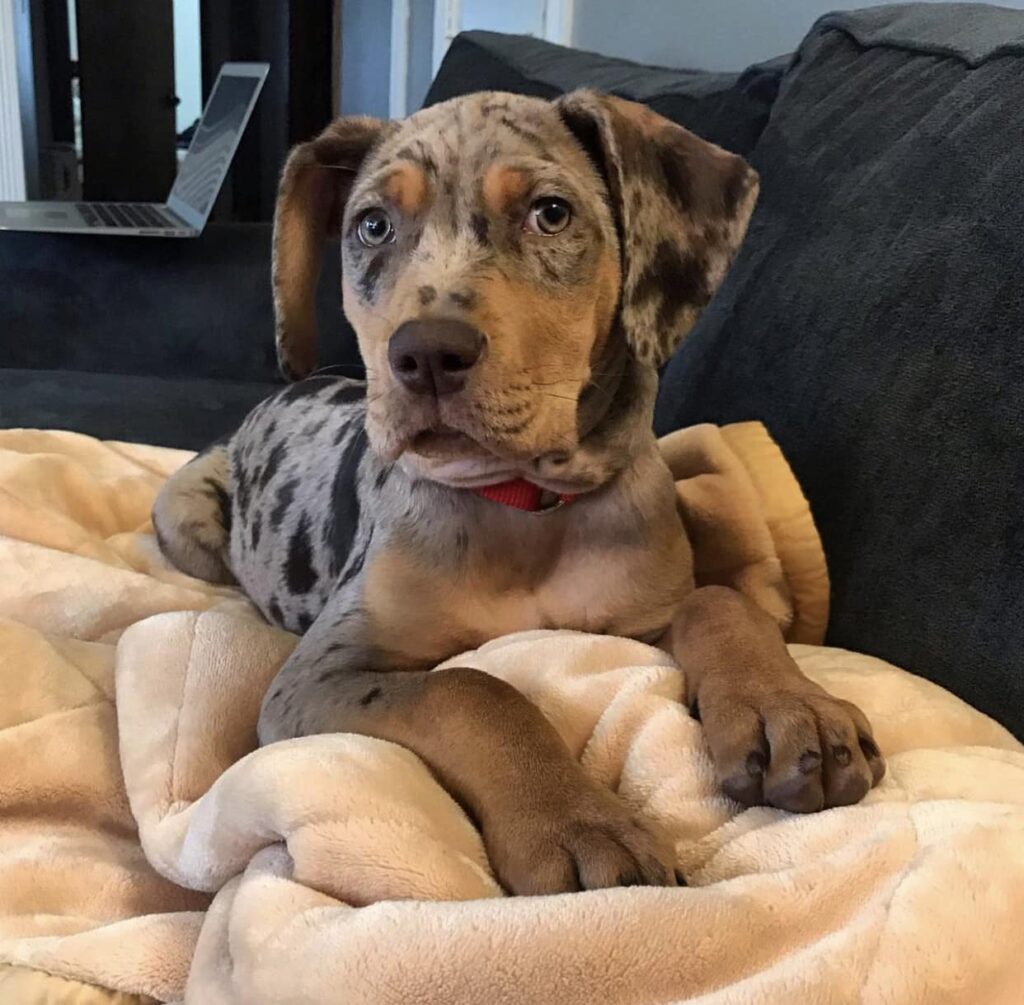
Understanding the behavioral traits of the Catahoula Leopard Dog is vital for anyone considering this breed. These dogs are known to be protective, often showing a strong sense of guardianship over their home and family. They also have high energy levels, requiring plenty of daily exercise to stay happy and healthy. These dogs show a good capacity for learning and obedience when it comes to training, but they need regular and systematic training to thrive.
These traits make the Catahoula Leopard Dog a versatile companion, capable of excelling in roles such as family pet, livestock herder, or watchdog. Knowing and adequately managing these characteristics helps owners ensure their Catahoula lives a fulfilling life.
Protective Instincts
Catahoula Leopard Dogs are known for their guardian temperament and are incredibly loyal to their families. These dogs naturally protect their home and can be a real asset to security, ensuring unwelcome visitors stay away.
But this protective streak might lead them to bark at strangers, which owners must manage to avoid unnecessary disturbance. Catahoulas aren’t typically aggressive with people but stand their ground when they sense their loved ones or home is threatened.
Owners should invest time training and getting these dogs comfortable with various people and situations. This helps the dogs distinguish between a friendly visitor and a real danger.
Energy Levels
Catahoula Leopard Dogs are a high-energy breed and thrive on plenty of exercise. They need at least an hour of daily activity to stay healthy and avoid behavior problems like chewing or barking too much.
Giving them tasks that challenge their bodies and minds is the best way to keep them happy. If they don’t get enough physical activity, these dogs might not act their best, showing just how vital exercise is for their happiness and health.
Training Responsiveness
Training a Catahoula Leopard Dog requires patience and understanding their unique personality traits. These dogs are known for their intelligence and eagerness to please, which can significantly aid the training process.
A consistent and kind approach is crucial in guiding them without causing stress or resistance. Training early is critical for nurturing good behavior and taking advantage of their obedience tendencies.
Keeping their minds engaged during training is vital to prevent boredom and discourage unwanted actions. This will result in a well-behaved and content companion.
Socialization Requirements
It is necessary to move from training to socializing Catahoula Leopard Dogs, exposing them to various situations and living beings. This helps them develop a friendly and stable personality. Taking them to dog parks regularly and letting them meet different people builds their social confidence. Research shows that this exposure is critical to helping them adjust their behavior.
While Catahoula Leopard Dogs can be affectionate with kids, always watch over their interactions to keep both safe. Positive reinforcement and consistency in social training can help prevent timidity or aggression. This approach is vital for raising a well-behaved dog.
Behavioral Consistency
Catahoula Leopard Dogs are known for their steady temperament, combining intelligence, energy, and a strong sense of independence. This blend of traits means they thrive with a consistent training routine.
As natural workers, these dogs have an autonomous streak that benefits from structured training. They may resort to unwanted behaviors like digging or chewing without proper mental and physical stimulation.
A training plan that uses positive reinforcement is critical to direct their energy positively. These dogs can also be prone to aggression towards other dogs of the same sex, so early socialization is vital to prevent fights.
While Catahoulas are resilient and can bounce back from training slip-ups, consistent guidance is the best way to ensure they grow into well-behaved companions.
Health Concerns & Management
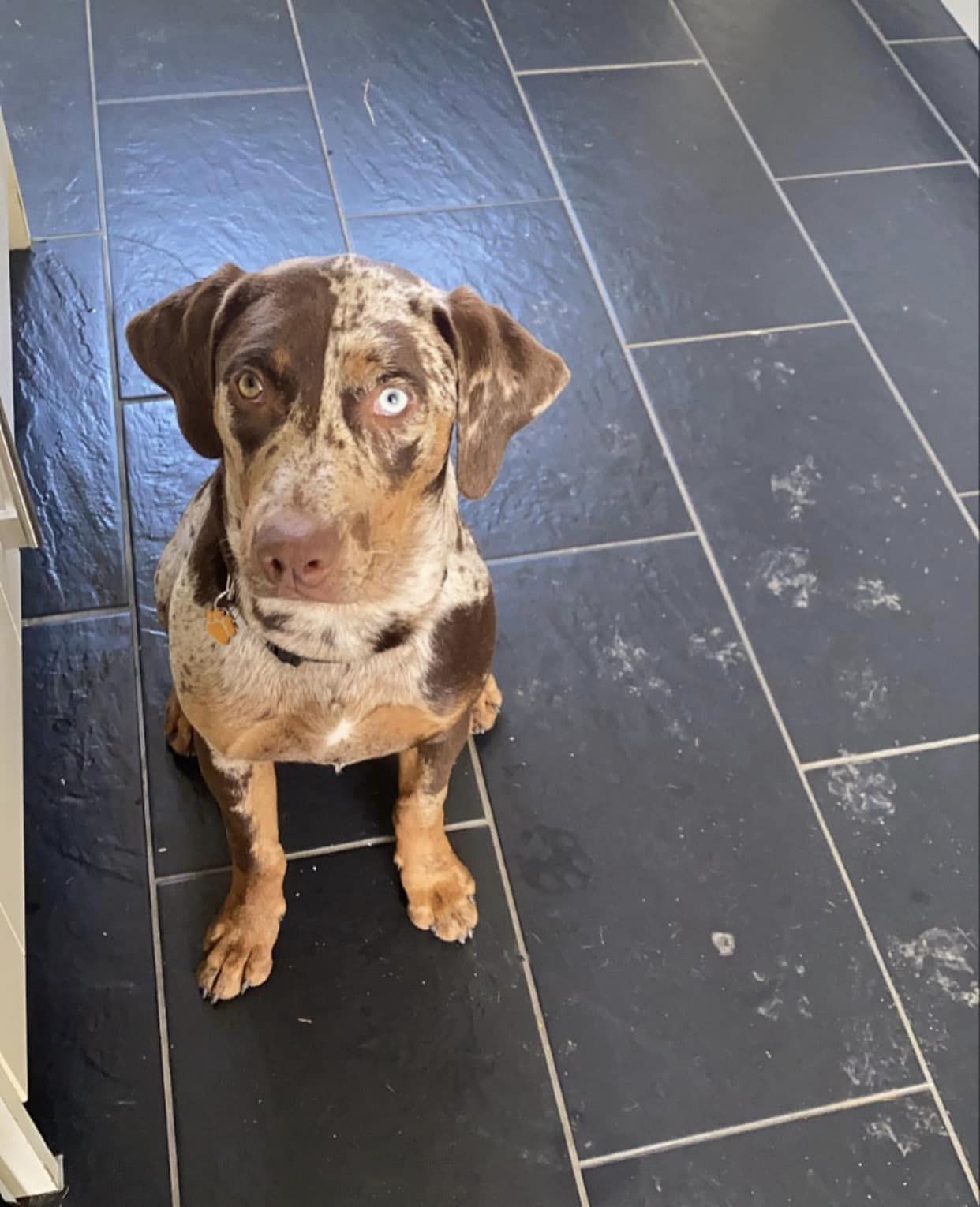
Despite their sturdy build, Catahoula Leopard Dogs may inherit health issues that need attention. Monitoring for common conditions like hip dysplasia and deafness is essential. Regular vet check-ups and genetic screenings are proactive steps to maintain their health.
Creating a customized care plan and lifestyle changes can address ongoing issues. These steps are based on solid research and are critical to the health of a Catahoula Leopard Dog.
Common Health Issues
Catahoula Leopard Dogs with a predominantly white coat are likely to experience hearing loss. Research shows a clear link between the amount of white in their fur and the risk of deafness.
The Orthopedic Foundation for Animals offers testing and certification to help breeders identify the chances of hip dysplasia, which can also affect this breed. Breeders should use thorough screening methods to lessen the likelihood of these issues passing to future generations.
Proactive measures like careful mate selection and early health screening are vital to safeguarding the well-being of Catahoula Leopard Dogs. Well-being needs to focus on the genetic health of their puppies to minimize these common health issues.
Preventative Care Strategies
Preventative care is critical to keeping Catahoula Leopard Dogs healthy and avoiding common issues. Reputable breeders should test for inherited conditions like deafness and eye problems.
Dog owners must take their Catahoulas for regular veterinary check-ups, including hearing and vision tests, to catch any problems early.
Feeding them a well-rounded diet that meets AAFCO standards is vital for their health and adjusts to their age and how active they are.
Regular exercise and mental challenges through training can stop bad behavior and keep their minds sharp.
These practical steps are the foundation for ensuring the well-being and joy of Catahoula Leopard Dogs.
Managing Chronic Conditions
Caring for Catahoula Leopard Dogs with chronic conditions requires a well-rounded strategy to improve their health and overall well-being. A hip joint abnormality that may lead to arthritis. Regular vet check-ups are recommended to catch any early signs of common problems. Keeping your Catahoula at a healthy weight and providing the right amount of exercise can also help lessen the impact on their hips.
In addition to joint issues, the merle gene in Catahoulas is associated with hereditary deafness and eye problems. Conducting thorough genetic testing before breeding is vital to help prevent these conditions from being passed on. A diet formulated for joint support and cautious breeding is critical to effectively managing these dogs’ health.
Maintenance & Management
Caring for a Catahoula Leopard Dog requires attention to a few essential practices that ensure their happiness and health. A simple grooming routine will keep their coat in good condition without much fuss. They need plenty of activity to burn off energy and stay out of trouble, so a regular exercise plan is necessary.
Regular vet visits are also necessary to catch and treat any health issues common to the breed early on. These steps are vital for keeping your Catahoula both physically fit and mentally sharp.
Grooming Requirements
Catahoula Leopard Dogs are known for their low-maintenance coats but still need consistent grooming to stay healthy and look good. Their fur varies from smooth to rough and requires weekly brushing to control shedding and keep them clean. This regular care helps spread the dog’s natural skin oils, giving their coat a healthy shine. You should bathe them every few months or more often if they get filthy.
Taking care of your dog’s teeth, nails, and ears is vital to avoiding common health problems like gum disease, uncomfortable nail length, and ear infections. Wiping around their eyes with a damp cloth can prevent any marks caused by tears. These simple yet effective grooming habits are essential to ensure your Catahoula Leopard Dog’s well-being.
Exercise Regimen
Catahoula Leopard Dogs need plenty of daily exercise to manage their high energy levels and avoid behavior problems. They thrive on at least one to two hours of activity daily to stay healthy both in body and mind.
Including a mix of swimming, hiking, and agility training in their routine is a smart way to keep them engaged and content. These intelligent dogs benefit from vigorous physical workouts at least three times a week for balanced energy use.
A fenced-in yard is also beneficial, as it provides a secure area for these dogs to move around and satisfy their natural curiosity and love for wandering.
Health Check Schedules
Catahoula Leopard Dogs need regular vet check-ups at least once a year to monitor and treat any heritable health issues. Since some of these dogs carry the Merle gene, which can link to deafness, it’s critical to have their hearing tested. This is particularly necessary for dogs working in fields where sharp hearing is essential, such as search and rescue.
A thorough record of health check-ups is beneficial for early detection and treatment of conditions like hip dysplasia. Hip dysplasia can worsen due to the breed’s intense hunting instincts and vigorous lifestyle.
Consistent veterinary care is critical to ensuring these dogs live a long and healthy life, allowing them to excel in any activity they undertake.
Training Commitments
If you’re the proud owner of a Catahoula Leopard Dog, you know these dogs are intelligent and lively. They need a training routine that keeps their minds and bodies active. Start training your Catahoula early with positive reinforcement. This approach taps into their natural intelligence and desire to please.
Consistent, patient, and kind guidance is crucial in positively directing their energy and strong will. Getting your Catahoula involved in dog sports can be a great way to burn off their energy and prevent the boredom that could lead to trouble.
Ensure they get at least an hour of exercise every day. This well-rounded care is vital for your Catahoula’s health and happiness.
Nutritional Needs
Catahoula Leopard Dogs have specific dietary needs due to their size and activity levels. These large and active dogs benefit from a diet that meets their energy and joint support requirements. Age, size, metabolism, and exercise habits dictate each dog’s ideal food portions and nutrients.
Feeding them with dog food that meets AAFCO standards helps maintain their health and prevent diseases.
Regular check-ups with a vet and careful monitoring of their diet can prevent obesity and related health issues. This attention to their nutrition helps keep Catahoulas healthy and enhances their overall well-being and lifespan.
Dietary Requirements
Catahoula Leopard Dogs thrive when their dietary needs are met with precision and care. A well-balanced diet is vital, tailored to their breed characteristics, size, and how active they are. Regular meal times help maintain their metabolism and promote digestive health. Identifying any food allergies or sensitivities is vital to prevent health issues.
Getting advice from a veterinarian is a smart move to ensure you’re providing the best nutrition for your Catahoula. They can offer guidance that’s specific to your dog’s unique needs.
Nutritional Needs
Catahoula Leopard Dogs thrive on a nutrient-rich diet that fuels their high energy and keeps them healthy. Pet owners must choose meals that comply with AAFCO guidelines and are appropriate for the dog’s age.
Talking to a vet before bringing a Catahoula puppy home can provide insights into the breed’s specific dietary needs. Opt for a large-breed formula to give them enough calories for their energetic lifestyle, but avoid overfeeding, which could lead to weight issues.
Regularly check their weight, adjust food portions, and exercise to keep them in top condition. Also, don’t feed your dog right after vigorous activity to prevent health issues like bloat.
Feeding Schedules
Setting up a consistent feeding routine is vital for the health of Catahoula Leopard Dogs. These large and active dogs need a diet that fits their size and energy demands. Follow the feeding guidelines from the dog’s specific food brand, and feed them twice daily to support their metabolism and help manage their weight.
It’s wise to give your dog a calm period before and after eating to reduce the risk of bloat, a severe health issue. Regularly checking your dog’s body condition helps adjust their food and exercise as needed, which is essential for keeping your Catahoula Leopard Dog in top shape.
Allergies and Sensitivities
When feeding Catahoula Leopard Dogs, allergies and sensitivities must be considered to keep them healthy. These strong and active family dogs can sometimes react badly to certain ingredients, showing signs like stomach upset, skin problems, or broader health issues.
Figuring out what’s causing these adverse reactions often involves a careful process, usually starting with an elimination diet and slowly bringing foods back to pinpoint the problem. Working with a vet to create a customized diet that avoids these allergens is essential.
Keeping their meals in line with AAFCO standards and free from known allergens is critical to maintaining the well-being of Catahoula Leopard Dogs.
